I was a fly on the wall. I was a member of the staff of the operational command under whose authority the destroyers USS Maddox and USS Turner Joy would enter the history books.
[Thomas Cleaver will be Thorne Dreyer’s guest Friday, August 8, on Rag Radio, 2-3 p.m. (CDT) on KOOP 91.7-FM in Austin, Texas, and streamed live here.]
Fifty years ago, on August 4, 1964, an event happened that turned my life inside-out, upside down (or so I thought at the time; in retrospect it was turned right-side-up), and 180 degrees from what it had been. As I came to deal with it, I would question everything I thought I knew about the history of my country, and my relationship to that country.
History knows the event as the “Tonkin Gulf Incident,” the beginning of formal American combat involvement in the war in Vietnam, that would spread to Southeast Asia, the causus belli that would send half a million of my fellow Americans into combat, leading to the death of more than 58,000 of them over the next nine years. More than a million Asians would die as a result. The United States would nearly be torn asunder, its future changed irrevocably.
I was a fly on the wall at that momentous event. At the time, I was a member of the staff of Commander, Patrol Forces, U.S. 7th Fleet (COMPATFOR7FLT), the operational command under whose authority the destroyers USS Maddox and USS Turner Joy would enter the history books.
Tonkin Gulf really wasn’t the beginning of American involvement in the Vietnam War.
Tonkin Gulf really wasn’t the beginning of American involvement, it wasn’t even the beginning of American combat involvement, in the Vietnam War. That stretched back (as I would come to learn) to our alliance with the nationalist Viet Minh during the Second World War. Had Franklin D. Roosevelt lived, American involvement would have been vastly different, since he planned to prevent the British and the French from resuming control of their pre-war Empires in Asia, with the countries of those empires becoming once again independent, as they are today.
Instead, the French were allowed to return in 1946, albeit without major American support. That changed in 1950 when the Korean War became a front line in the struggle against “international communism,” and France was able to make the argument that their fight in Indochina was indistinguishable from that in Korea.
While the French proceeded to continue losing their war, American involvement insured there would be no final resolution when France withdrew.
South Vietnam was created in the Geneva Conference of 1954, fully supported by the United States. Following abrogration (with U.S. support) of the planned elections that would have reunited north and south Vietnam, the guerilla independence movement resumed in the late 1950s. That was met in 1961 by the resolute determination of President Kennedy that we would “bear any burden, support any friend, oppose any foe,” while young Americans like me were to “ask not what your country can do for you, but rather ask what you can do for your country.”
By the time I joined the Navy in 1962, there were 1,500 military ‘advisors’ in South Vietnam.
By the time I joined the Navy in 1962, there were 1,500 military “advisors” in South Vietnam, first sent in 1961. During the summer of 1962, while I learned to march in step in boot camp, American pilots began flying combat missions in the war. Theoretically, they were still “advising,” since a Vietnamese pilot was supposedly in control of the airplane. In reality, any Vietnamese from “hootch boy” on up might be in the cockpit, but the American there was running the show.
Looking back, I find it amazing that in 1962-’63, an otherwise-intelligent young man — who even had what he thought was a better-than-average understanding of history — could convince himself that service in the American military was part of a continuum defending and promoting freedom around the world — that could include older guys who had been my heroes in high school who were joining the Peace Corps, and a former school president who was in a jail in Americus, Georgia, for the crime of working for civil rights in SNCC.
Such was the way it was possible to think under the influence of John F. Kennedy and the New Frontier.
In the spring of 1963, I got orders sending me to the Western Pacific. While waiting at the San Diego Naval Station for transport west, I became friends with the young sailor in the rack next to mine in the transient barracks. Sadly, I only remember his name was Dave. We became better friends during a week of firefighting training to which we were assigned while waiting (the idle hands of enlisted men being the Devil’s Workshop to the Navy). We both made the trip to Yokosuka, Japan, where we parted ways, he being headed for a job as a fire control technician (the guys who fire the guns) aboard a destroyer home ported there in Japan, the USS Maddox.
Patrol Forces 7th Fleet was just what the name implies. Squadrons of navy patrol planes flew from bases in Japan, Okinawa, and the Philippines, flying along the borders of the Soviet Union across the Sea of Japan, and China from the Korean peninsula to the South China Sea. The job was electronic intelligence, gathering everything possible from communist sources, and it was not without danger.
International waters in those days were the ancient Three Mile Limit. The USSR and PRC had begun to claim the now-standard 12-mile limit. The patrols were supposedly flown at six miles off the coasts, but with World War II technology still in wide use — particularly with aerial navigation — it wasn’t unusual for an airplane flying over a deck of clouds to find a hole in the clouds and discover it wasn’t blue down below.
“Incidents” happened, with Soviet and Chinese jet interceptors making the occasional appearance. In some unusual events, shots were exchanged, and on several occasions before I got there, airplanes went missing.
Destroyers like the Maddox took their turn on what was called the Formosa Straits Patrol.
Destroyers like the Maddox took their turn on what was called the Formosa Straits Patrol. Initiated in 1950 to prevent invasion of Formosa (now Taiwan) from the mainland, the patrol had also become a way of preventing the Nationalists from creating an “incident” in the straits that could escalate.
My very low-level job (which still required a Top Secret security clearance) was keeping track of who was assigned to do what, when. Every 90 days a book would be published with all the schedules laid out and assignments made. These would begin to change within days of the book’s appearance, and it was my job to pencil in the changes as they continued to occur.
Yes, it was time-consuming, but for me it wasn’t boring. I was interested in how the navy operated. I knew most of the ships and their histories, and I could entertain myself keeping up with all this. I also kept up with current events since I typed up the Admiral’s Daily Briefing.
Life wasn’t too bad aboard whichever of the three seaplane tenders — USS Salisbury Sound, USS Pine Island, and USS Currituck – was deployed as flagship. We all liked the Currituck best, since she had been pulled from mothballs in 1960 and equipped with shipwide air conditioning, something the other two lacked.
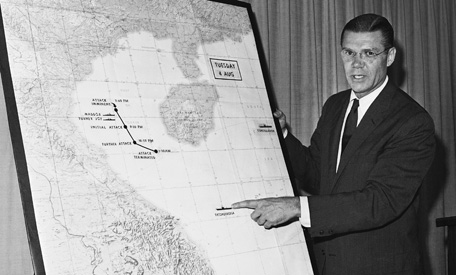
Secretary of Defense Robert S. McNamara in post-midnight press briefing at the Pentagon on Aug. 4, 1964. Photo by Bob Schutz / AP.
The ships were normally anchored in Buckner Bay, Okinawa, where they operated flying boat detachments from the squadron in the Philippines. There were also “show the flag” trips throughout western Asia, and I eventually was everywhere from Japan to Australia. “Join the Navy and see the world” had paid off for me. I didn’t realize it at the time, but I had developed a different response to being away from home than had most of my fellow sailors.
I made friends in those places we visited. Japanese, Chinese, Filipino, British, Australian. They were not people who worked in the waterfront bars and other places of ill-repute sailors were usually found in. I was getting to know something of the world, gaining a wider perspective.
We also made two trips to South Vietnam, during both of which I heard stories of the war from fellow Americans who were now a much larger presence (some 15,000) than originally. Vietnam became something that was always percolating in the background of everything else.
In early 1964, a new surface ship patrol area was added: the Gulf of Tonkin.
In early 1964, a new surface ship patrol area was added: the Gulf of Tonkin. The various patrols were named for watches; this became the Bulova Patrol. It involved a destroyer running along the coast of North Vietnam, some 50 miles at sea. While the Formosa Straits patrols originated with ships based at Yokosuka, this patrol used ships from Subic Bay, the major U.S. naval base in the Philippines.
In July, one of the Daily Briefing reports made mention of deployment changes to meet “the growing threat” of action from North Vietnam. Then I saw parts of an operation order from CINCPAC (Commander In Chief, Pacific Forces) assigning units for possible attacks against four North Vietnamese ports, “upon provocation.”
At the end of the month, one of the assignment changes I updated included the assignment of USS Maddox in support of “34-Alpha ops” in the vicinity of Hon Me Island, a North Vietnamese-controlled piece of geography a hundred miles out from the coast in the middle of the Tonkin Gulf. The assignment was set to commence on August 1, 1964. I was curious as to what a “34-Alpha op” was and looked it up: “Operations by units of the Navy of the Republic of Vietnam.”
August 2, 1964 – Oh-Dark-Thirty: I had the ‘mid watch’ in Flag Ops.
August 2, 1964 – Oh-Dark-Thirty: I had the “mid watch” in Flag Ops. In those pre-war days, this involved lining up all the chairs in the office and sleeping on them, hopefully not to be awakened by anything happening one would need to notify the Admiral or the Chief of Staff about. Such was not to be the case that night. Actually, it was about 0230 when the radio shack messenger woke me. I scanned the message: FLASH/URGENT/TOPSEC: USS Maddox under attack.
The rest of the night was an example of the “fog of war” as the Operations Staff officers all did their best to figure out what was what. Apparently Maddox had spotted North Vietnamese torpedo boats and engaged them. I would learn later that day that this was an “expected response” to the ship shelling Hon Me Island in support of the “34-Alpha op,” which turned out to be a South Vietnamese commando raid on the radar station on the rocky outcropping recognized by international law as being North Vietnamese territory.
The next 24 hours were tumultuous. The result was that USS Maddox was joined the afternoon of August 3 by USS Turner Joy. The Bulova Patrol was to continue. I swapped mid-watches with a friend who wanted to celebrate his birthday ashore, figuring lightning wouldn’t strike twice.
There was no sleep for the wicked or the innocent again the early morning hours of August 4, as both Maddox and Turner Joy reported being under attack by those pesky torpedo boats. This time, however, no one opened fire. Confusion reigned.
Or I should say, confusion reigned among those trying to make sense of things at the scene of the crime. There was no confusion back in Washington, as the Johnson Administration used the “attacks” and the U.S. response — bombing the four North Vietnamese ports in the operation order put forward in July for use “upon provocation” — and then rushing the Tonkin Gulf Resolution through Congress, the piece of paper used ever afterwards as the-same-as-a-real-declaration-of-war to justify all that followed.
As all that was going on, USS Pine Island was steaming from Okinawa to DaNang, South Vietnam. The northernmost harbor in the country was turned into a seaplane base for a month, a harbinger of what would come the following year when Operation Market Time was put in play under the direction of the Seventh Fleet Patrol Force. It was designed to stop “North Vietnamese infiltration by sea,” but I don’t think anyone other than confused South Vietnamese fishermen ever fell foul of that.
At the end of the month of operations, we put into Subic Bay.
At the end of the month of operations, we put into Subic Bay, well-known as the “armpit of Southeast Asia” (some might consider another bodily reference more accurate). Strolling the streets of Olongapo on liberty, I stopped in a bar for a cold San Miguel. Who should be sitting at the bar but my old friend from firefighting school, Dave. I immediately noticed the lines of empty stitching on his sleeve where a third class petty officer’s “crow” had recently been. Over a second beer, I finally asked him what happened.
“Got busted.” (That’s obvious, how?)
“Court martialed.” (Coming back late from liberty a time or two?)
“So, what for?”
“Failure to obey a direct order.” (Whoops, we’re in a little deeper than originally suspected.)
“What?”
“Open fire.”
And with that he told me the story of the Maddox in the Gulf of Tonkin. That he never saw any “enemy boats” on the fire control radar during the first incident, but a buddy on lookout duty had sworn he saw them in the moonlight. How the second night was even darker. “The only thing out there was the other ship. I told the captain three times. The commodore was convinced they were there and kept pushing the old man. He gave the order and I said ‘No, sir. The only thing out there is the Turner Joy.’”
For his effort to follow the Rules of Engagement, and for taking the hard choice of refusing an order that would cause a tragedy of major proportions, the kind of “international incident” that in the middle of the fog of war could have led directly to out and out war, my friend had been given a Special Court-Martial, reduced in rank one grade, and lost his recommendation for re-enlistment (an important thing in those days of old).
I’ll never forget the last thing he said: “It was all bullshit, man. A lie on top of a lie. There was never anything. We weren’t shooting at any enemy boats.” I wanted to know more but he put aside my questions, and walked out of the bar.
Three years later, now long out of the Navy, I met Dr. Peter Dale Scott, a Cal-Berkeley academic who was convinced the Tonkin Gulf Incident was a lie. I told him my story. A week later he introduced me to a graduate student working with him. He turned out to have been the Assistant Gunnery Officer aboard the other destroyer, the Turner Joy. He’d been able to convince his captain there was nothing out there in the darkness but another American ship.
He said that in fact his captain had formally reported his belief there was no incident, but it had gone nowhere. There was no way to get at the truth, since it was “probably in some Pentagon sub-basement,” as Dr. Scott put it.
In the fall of 1970, CBS’ Sixty Minutes broke a story that contended things had not been as officially reported.
In the fall of 1970, CBS’ Sixty Minutes broke a story that contended things had not been as officially reported in the Tonkin Gulf Incident. Hallelujah! Someone was going to do something finally! I wrote a letter to the producers, telling the story in detail. A week later the phone rang. It was legendary newsman Joseph Werschba of Sixty Minutes, a reporter who went back to being one of “Murrow’s Boys.” He told me he had shown my letter to a senator on the Senate Armed Service Committee and the senator had confirmed the story by declining to call it a lie when offered the opportunity.
The next summer, June 1971, The New York Times published the Pentagon Papers, Daniel Ellsberg’s gift of the truth to the American people about the lies and crimes of Vietnam. There was the story, in detail. The South Vietnamese commando raid on the territory of sovereign state with which neither the Republic of Vietnam nor the United States was at war, the destroyer Maddox assigned to provide fire support — which was what had prompted the original report of guns having been fired.
As a final postscript to all of that, in 1995 I made the acquaintance of retired Navy Lieutenant Commander Richard H. “Dick” Best Jr., the very genuine American hero who had turned around an American defeat at the Battle of Midwway into the most important American victory of the Pacific War when he single-handedly sank the Japanese carrier “Akagi.”
But it turned out that Dick Best did not believe his actions over the Japanese fleet 50 years earlier were the most important service he had rendered his country. In the 1960s, he had become librarian of the RAND Corporation, and had eventually become friends with Daniel Ellsberg. “I was the one who turned a blind eye to his removal of the Pentagon Papers from the library to copy them.”
As I came to understand, studying American history over the past 50 years with the benefit of knowledge of the truth of what I call the Alleged Tonkin Gulf Non-Incident, this was certainly not the first time in American history such a thing had happened. The “sinking” of the battleship Maine in Santiago Harbor, Cuba, provided “Remember the Maine!” as battle cry for the first of our Imperial Wars. Medical students “under threat” justified the invasion of Grenada in 1983. “Dealing with drug dealers” provided the excuse to topple Noriega in Panama in 1990. Most recently, the claim of Saddam possessing “WMDs” justified little George Bush’s invasion of Poland, er, I mean Iraq.
But Tonkin Gulf was and still is The Big One. The one we should never forget. The lie that came as close as anything to destroying the United States.
[Vietnam veteran Thomas McKelvey Cleaver is an accidental native Texan, a journalist, and a produced screenwriter. He has written successful horror movies and articles about Second World War aviation, was a major fundraiser for Obama in 2008, and has been an activist on anti-war, political reform, and environmental issues for almost 50 years. Read more articles by Thomas Cleaver on The Rag Blog.]

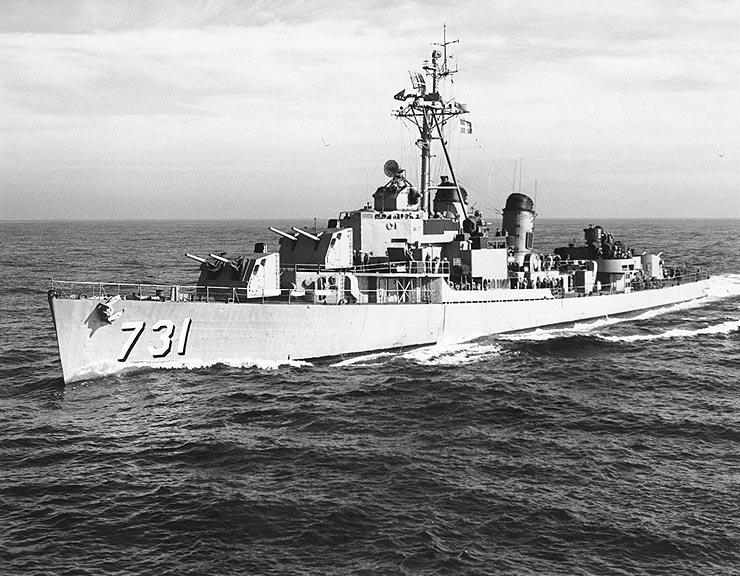
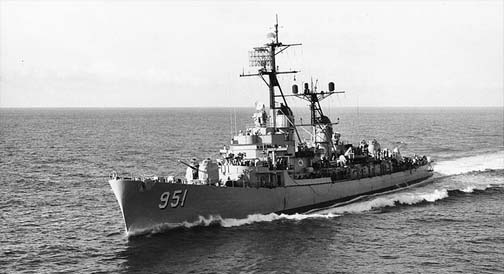
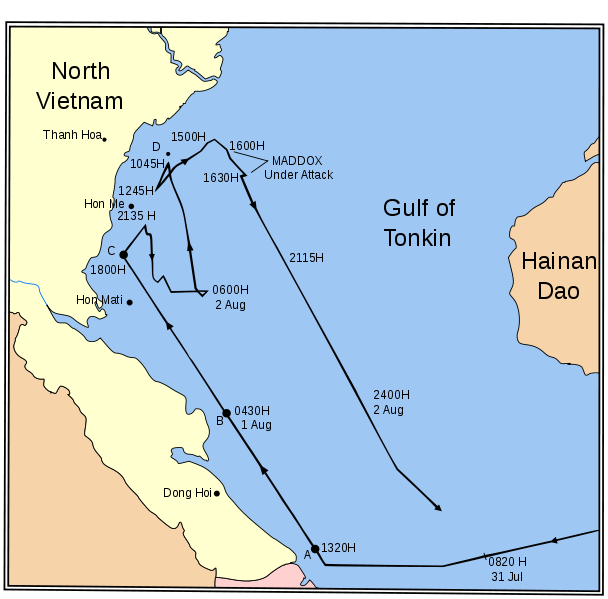
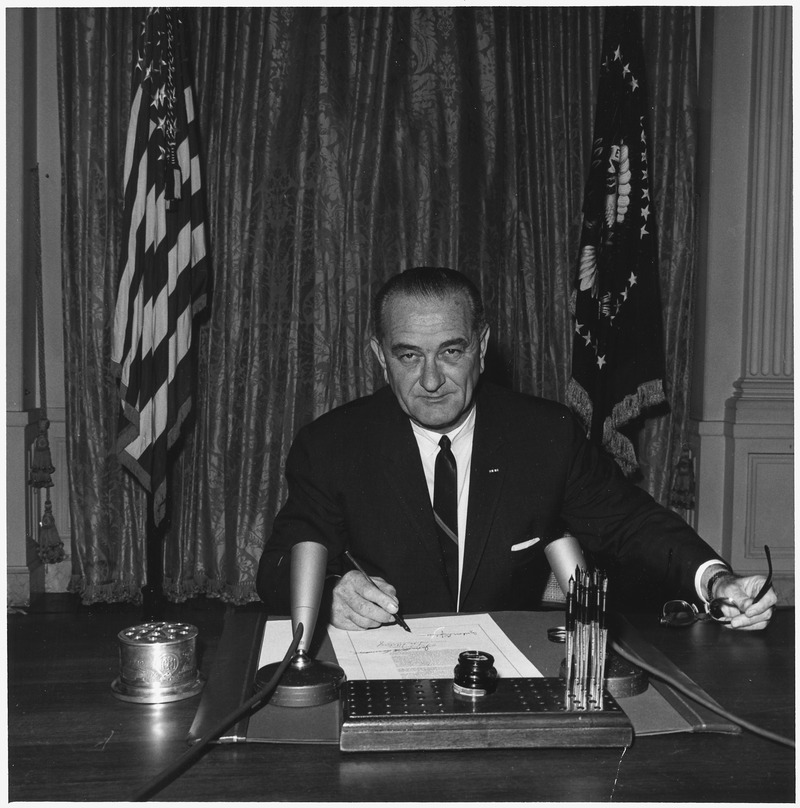
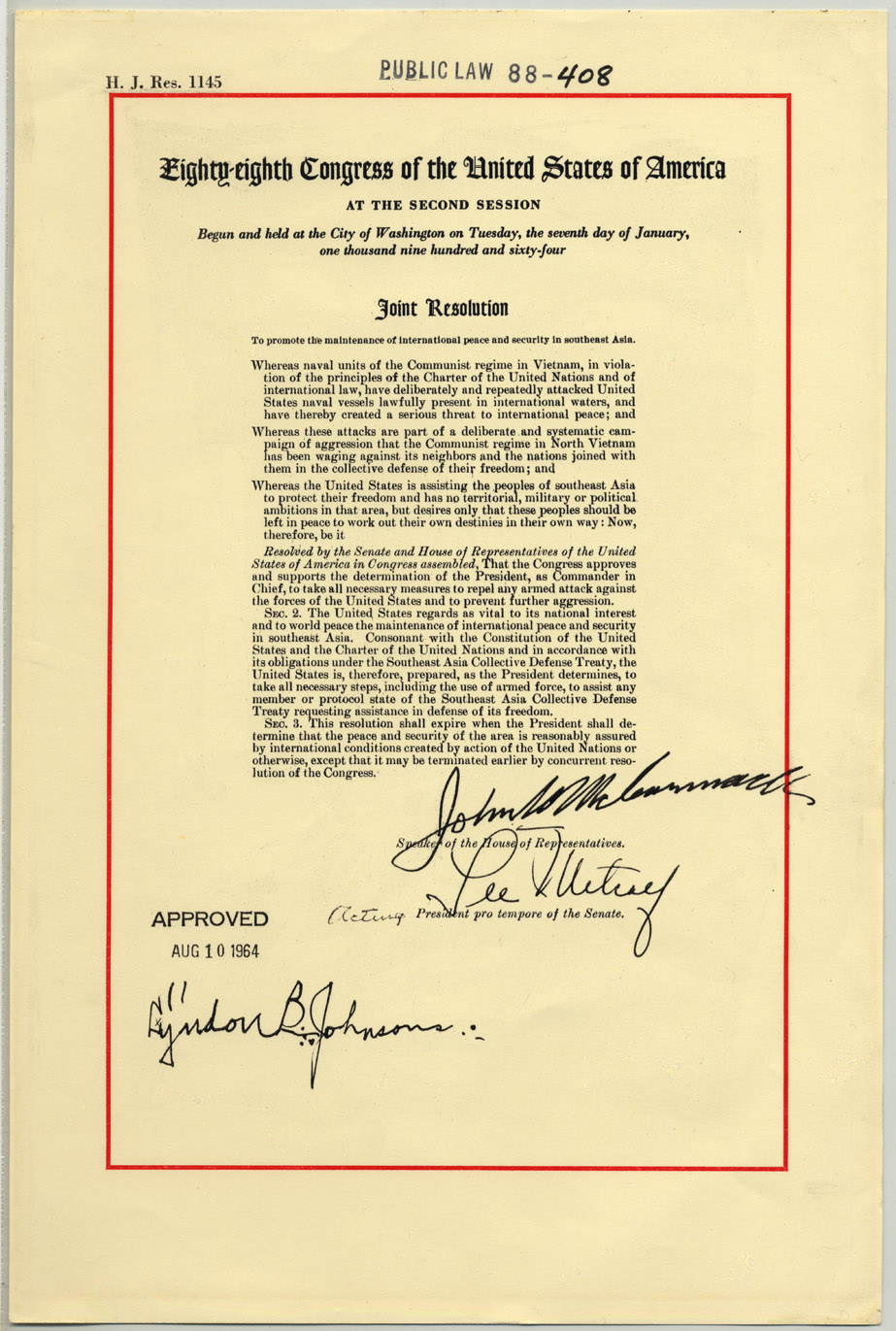
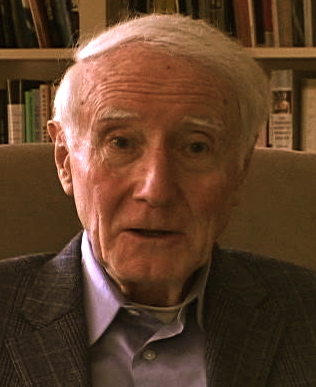
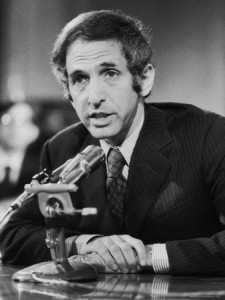

















A remarkable story, Thomas. Thank you very much for sharing this with us.
Tom, Thank you so much. What a place to be a “fly on the wall.” As Tom Hayden often says, “This is a fight about memory.” You have added great dimension to our memory of Vietnam.
Excellent work, Mr. Cleaver. A very well-written piece of history that all Americans should read.
Thorne
I noticed your guest will be recognizing the anniversary of the Gulf of Tonkin. Syracuse students, at least when I was there, always took note of the stain left on the plaza of Pei’s Newhouse school building, a plaque noting Johnson’s speech. This commemoration in my view is similar to the 1956 “Children’s Pledge” plaque which denies slavery as a civil war issue. It is hidden in a narrow corner off of the north east side of the state capitol’s rotunda here, behind the Ma Ferguson bust which I coincidentally call “LBJ with a bun.”
Greg
The roots of the Newhouse School are found in Syracuse University’s former School of Journalism, which was founded in 1934 under Dean Lyle Spencer. At that time the curriculum was dedicated mainly to print media.
That year—the year the FCC wrote the Communications Act that would shape the emerging field of broadcasting for decades to come—SU became the first university in the nation to offer a college credit radio course. In 1947, SU launched WAER, one of the nation’s first college radio stations. And when television emerged in the years following World War II, SU was the first to offer instruction in this fledgling field.
In 1964, supported by a gift from Samuel I. Newhouse, the Newhouse Communications Complex was officially inaugurated in Newhouse 1, the award-winning I.M. Pei building, which housed the School of Journalism. (A year later, the building would be cited as one of the top four honor award winners of the American Institute of Architects.)
In his dedication speech, Mr. Newhouse noted, “it is right and fitting that such a communications center be located within a dynamic university with world-embracing interests. The many fields of study provide an unparalleled opportunity for the interplay of creative talents of the first rank.” President Lyndon B. Johnson joined Mr. Newhouse at the dedication that day in 1964, accepting an honorary degree and delivering his famous “Gulf of Tonkin Speech” on the Newhouse Plaza.
The idea that revealing and commemorating a US black op/PR ploy will somehow restrain the state from further such “adventures” is ludicrous and patently false. Exhibit A:
“Thomas McKelvey Cleaver … was a major fundraiser for Obama in 2008 …”
It’s just another case of an “activist” who reeks of sanctimony and would hang his head in shame if he had any.
I am wanting to get in touch with the augh or of the new book”Fabled Fifteen” as my father was Rear Admiral VG Lambert. I would like to thank him for writing this story.
Rita Pescatore
Tom what you know of Project 112 or SHAD?
I knew McDougal on Fulbright Staff, lyou are right on
but there is much more to know.
Try Part I and Part II of Michael Shrimption on projectcamelot
and listen to who McNamara was and what were his orders.
I read the story and I am glad someone out there is trying to get the real story out. My father-in-law was a part of this incident, as he worked on the USS Yorktown which was part of the 7th fleet during this time period. He has been trying to find any information about this, and so far no mention that the aircraft carrier even being there can be found. I would love for anyone out there to send me information if you have found it.